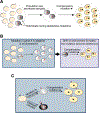Evolutionary Repair Experiments as a Window to the Molecular Diversity of Life
- PMID: 32428498
- PMCID: PMC7295036
- DOI: 10.1016/j.cub.2020.03.046
Evolutionary Repair Experiments as a Window to the Molecular Diversity of Life
Abstract
Comparative genomics reveals an unexpected diversity in the molecular mechanisms underlying conserved cellular functions, such as DNA replication and cytokinesis. However, the genetic bases and evolutionary processes underlying this 'molecular diversity' remain to be explained. Here, we review a tool to generate alternative mechanisms for conserved cellular functions and test hypotheses concerning the generation of molecular diversity - evolutionary repair experiments, in which laboratory microbial populations adapt in response to a genetic perturbation. We summarize the insights gained from evolutionary repair experiments, the spectrum and dynamics of compensatory mutations, and the alternative molecular mechanisms used to repair perturbed cellular functions. We relate these experiments to the modifications of conserved functions that have occurred outside the laboratory. We end by proposing strategies to improve evolutionary repair experiments as a tool to explore the molecular diversity of life.
Copyright © 2020 Elsevier Inc. All rights reserved.
Figures


References
-
- Balasubramanian MK, and Bi E, and Glotzer M. (2004). Comparative Analysis of Cytokinesis in Budding Yeast, Fission Yeast and Animal Cells. Curr. Biol. 14, 806–818. - PubMed
-
- Velle KB, and Fritz-Laylin LK (2019). Diversity and evolution of actin-dependent phenotypes. Curr. Opin. Genet. Dev. 58–59, 40–48. - PubMed
Publication types
MeSH terms
Grants and funding
LinkOut - more resources
Full Text Sources

